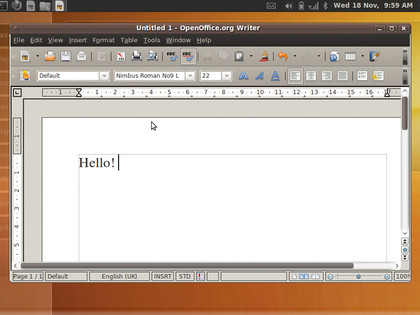Linux on the move: the future of portable distros
What to expect from Moblin, Android, Chrome OS and more
Usability
If improved usability is your main concern, you can do a lot worse than choose UNR or one of its derivatives. The large icons used by the application launcher and the low resolution of the default applications would be ideal for those with impaired vision or limited input mobility.
As UNR is really just a series of additional packages built around Ubuntu, it will also work on the same vast array of hardware, from the oldest supported by the kernel to the newest devices. Unlike some of the other netbook distributions available, UNR will also install without too much difficulty.

This is because UNR is distributed as an ISO disc image. It just needs to be burned on to a disc, which is then inserted into the destination machine. Most other netbook distributions prefer the flash image format, IMG, which isn't as versatile if you don't have a USB flash drive, and it can also be rather difficult to create the appropriate boot media.
If you've used Ubuntu, UNR looks different but operates in exactly the same way. Many of the bundled applications are identical, and other than the new title bar and the change in theme, they'll work in exactly the same way.
More importantly, the big advantage it has over Moblin is that you can install all the same packages you can from a normal Ubuntu installation using the Synaptic package manager, which is probably the best reason for using it.
We pit the big two netbook distros against one another in a race!
Sign up for breaking news, reviews, opinion, top tech deals, and more.
We interpreted speed as how quickly the machine boots, how long it takes to establish a wireless internet connection, suspend and resume speeds, as well as general performance and battery life, and we've tested both distribution on the same machine.
It's a Samsung NC10 with 1GB of memory and a 160GB hard drive, connected to the same wireless network while plugged into power. Both distributions work well on this device, although we had to update the BIOS for the screen brightness control to work, and Moblin fails to offer a GUI for this.
Both our series of tests were conducted from a cold boot, and we took the timings from the moment we selected the OS from the Grub menu.
Suspend/resume
To measure the time it took to suspend the machine, we waited for the power light to start flashing. With Moblin, the screen went dead instantly and it took a few extra seconds for the hardware to close down and enter suspend mode.
On UNR, we could see the screen and watch the audio being muted followed by the wireless connection being dropped before suspend mode was triggered at almost exactly the same time.
This housekeeping is perhaps why UNR is a little faster at restoring the desktop and reconnecting to the wireless access point than Moblin, although there was some variation in the UNR results, with the fastest wireless resume coming in at under 20 seconds.
We had expected the suspend and resume times to be almost identical, and it's remarkable that both desktops were back up and running in under five seconds, with UNR posting a particularly impressive speed. It's also clear that the the biggest bottleneck is waiting for the wireless radio to negotiate a new connection, as both systems spend about the same amount of time waiting for an internet connection.
Moblin is dramatically quicker at booting, even though the wireless connection is delayed, and you can see why Canonical has been watching Moblin development very closely, and why both distributions are promising further improvements.
It's also noteworthy that the UNR desktop appears with a working wireless connection immediately, whereas we have to wait for Moblin to make the same leap, which shows that UNR is performing certain tasks at the same time. Perhaps that's one of the reasons why Moblin is faster to the desktop?
The only test where we couldn't pick a winner between the two distributions was battery life, as they both gave roughly the same results. In normal, low-power command line usage, we got around 5.5 hours out of each netbook, while continually running the BBC's iPlayer gave us around 2.5 hours of playback.
Results

Current page: UNR 9.10 vs Moblin 2.1
Prev Page Mobile Linux on netbooks and desktops Next Page Linux on mobile phones